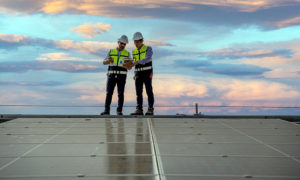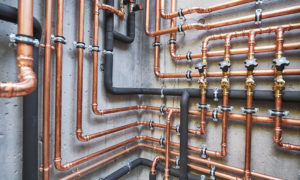Commercial buildings experience wear and tear, just like any other property. Over time, though, these small issues can snowball into larger ones, particularly without preventative maintenance. To ensure you don’t forget anything important, it is wise to create a preventative maintenance checklist.
Preventative Maintenance Checklist: What Is Preventive Maintenance?
Before assembling your own checklist, it is first important to understand what preventive maintenance is and why it is essential. What is preventative maintenance? Simply put, it is the process of regularly maintaining the various parts, fixtures, and equipment of a property to prevent massive issues and malfunction. Performing preventive maintenance is critical to the uninterrupted use of a space or asset.
What to Include in Your Preventative Maintenance Checklist
Preventive maintenance is vital to any commercial property. But, not all property owners know where to begin. To get you started on the right foot, here are the things you should always include in your building preventive maintenance routine.
1. Openings
You must inspect all doors and windows to ensure they work fine. Most of these are built using durable materials, so your main focus will be on the little parts that make them function. Check handles, locks, and hinges to see if they need replacing. If your commercial property has a gate, make sure it opens and closes properly, too.
2. Floors
Many owners neglect their floors, leading to larger problems down the road. While regular sweeping is imperative, floors also need a deep cleaning every once in a while. The kind of cleaning floors should get will depend on the material it is made of. Carpets, for instance, will require thorough vacuuming and treatment every 4 to 6 months or so. The method may differ for hardwood floors, tile floors, etc.
3. Exterior Walls
The appearance of a commercial building’s exterior can make or break a good first impression. As such, it is important to keep your exterior walls clean and free from problems. Make sure to check these walls every month. Look for damages like cracks and breakage. If you spot any, address them before they worsen.
 4. Roofing
4. Roofing
It is equally imperative to pay attention to your building’s roofing. Inspect your roof at least twice a year — more often if you live in an area that experiences frequent inclement weather. Check the roofing tiles and connections for any visible damages. Gutters and drains should be cleared of any debris to allow water to pass freely. Look for signs of leaks or water damage, too.
5. Lighting
Lights can define the atmosphere of any commercial property. As part of your preventative maintenance checklist, make sure to inspect all lighting fixtures for any signs of damage. Screws and hardware should be secure, while cables should have no tears. It is also essential to clean lens surfaces as well as dust lamps on a routine basis. Gaskets should also be replaced. If you find any burnt bulbs, switch them out for new ones.
6. Electrical
Your electrical system is the engine that powers everything else in your commercial building. Thus, it is paramount that you keep it in excellent condition. To do this, check breaker boxes, outlets, wires, switches, and batteries on an annual basis. Make sure there are no signs of damage or corrosion. You should also clean electrical storage and circuit boxes to keep dust and dirt away. If you have elevators, have a technician inspect them regularly.
7. Plumbing
A poorly functioning plumbing system is not only inconvenient but also downright unhygienic. As part of your plumbing checks, make sure to replace oils and refrigerants appropriately, look for leaks in couplings, inspect plumbing fixtures in bathrooms and kitchens, and check water heaters as well as boilers. Check for signs of water damage. You should also examine sump and sewage pumps every year.
8. HVAC
When your HVAC system doesn’t function properly, it can cost you thousands of dollars in utility bills and repairs. Your HVAC system should stay in optimal condition to keep it energy efficient. Additionally, a good HVAC system can improve indoor air quality and make for a more comfortable environment.
Inspect your HVAC system and its many components to see if there are signs of damage. Recharge P-traps and U-bend water traps, replace missing screws, and repair broken gaskets. Do all of these twice a year, minimum.
Additionally, you should also routinely replace air filters, check for coupling leaks, lubricate pumps, and clean the condenser coil. To allow for peak energy efficiency, examine the settings for your compressor, thermal expansion valve, and refrigerant charge every once in a while.
More often than not, property owners don’t have the expertise necessary to keep their HVACs up-to-date. As such, it is best to outsource the job to an experienced professional.
9. Safety
Safety is of chief importance in any commercial building. To improve safety, make sure to inspect for faulty wiring and replace them immediately. You should also check that all smoke and carbon monoxide alarms are working properly. Most jurisdictions follow the international building code, though some local areas do have their own. Your building should adhere to these standards to avoid potential liability.
10. Security
If you have a built-in security system, make sure to have it serviced every year. This way, you can ensure there is no downtime, which can lead to a security risk. If you have video surveillance cameras, check that they are fully functioning on a regular basis. It is also imperative that someone constantly monitors the feed to spot any potential threats early on.
11. Fire Safety
Fire is one of the most common hazards that commercial buildings face. Particularly in taller buildings, fire can quickly spread and trap occupants, endangering their lives. To ensure fire safety, make sure all fire and smoke alarms are working properly. You should also examine sprinkler heads and pull stations. Fire extinguishers should be present on every floor and serviced once a year. Additionally, make sure there is nothing blocking the fire exits.
Preventive Maintenance Checklist Template
Creating your own checklist can be difficult if you’ve never done it before. To help you out, here is a preventive maintenance template you can use.
Openings
- Inspect all doors and windows
- Check handles, locks, and hinges
- Make sure gates open and close properly
Floors
- Schedule a deep cleaning every once in a while
- Check for cracks and damages
Exterior Walls
- Clean exterior walls
- Look for damages like cracks and breakage (and address them)
Roofing
- Inspect your roof at least twice a year
- Check the roofing tiles and connections for any visible damages
- Gutters and drains should be cleared of any debris
- Look for signs of leaks or water damage
Lighting
- Inspect all lighting fixtures for any signs of damage
- Screws and hardware should be secure
- Cables should have no tears
- Clean lens surfaces as well as dust lamps on a routine basis
- Gaskets should also be replaced
- Switch out burnt bulbs for new ones
Electrical
- Check breaker boxes, outlets, wires, switches, and batteries on an annual basis
- Make sure there are no signs of damage or corrosion
- Clean electrical storage and circuit boxes
- Have a technician inspect your elevators regularly
Plumbing
 Replace oils and refrigerants appropriately
Replace oils and refrigerants appropriately- Look for leaks in couplings
- Inspect plumbing fixtures in bathrooms and kitchens
- Check water heaters as well as boilers
- Check for signs of water damage
- Examine sump and sewage pumps every year
HVAC
- Inspect your HVAC system and its many components for signs of damage
- Recharge P-traps and U-bend water traps
- Replace missing screws
- Repair broken gaskets
- Routinely replace air filters
- Check for coupling leaks
- Lubricate pumps
- Clean the condenser coil
- Examine the settings for your compressor, thermal expansion valve, and refrigerant charge
Safety
- Inspect for faulty wiring and replace them immediately
- Check that all smoke and carbon monoxide alarms are working properly
- Adhere to local building codes
Security
- Have your security system serviced every year
- Ensure video surveillance cameras are fully functioning
Fire Safety
- Make sure all fire and smoke alarms are working properly
- Examine sprinkler heads and pull stations
- Fire extinguishers should be present on every floor and serviced once a year
- Make sure there is nothing blocking the fire exits
Better With a Professional
Clearly, having a preventative maintenance checklist that you can follow will help you keep your commercial property and all of its components in tip-top shape. But, even with a checklist, you can’t perform all of these tasks yourself.
Maintenance Specialists Inc. offers preventive maintenance services to commercial properties. Call us today at 704.405.6000 or contact us online to learn how we can help you.
RELATED ARTICLES:
- Preventive Maintenance Schedules For Commercial Properties You Can Follow
- 9 Reasons Why Commercial Floor Cleaning Is Important For Commercial Buildings
- HVAC Maintenance: The Benefits, Process, And Finding The Pros

